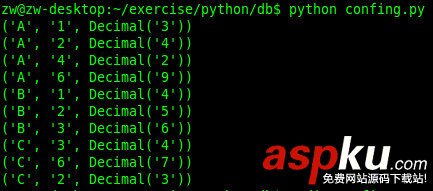一、安装
1、安装easy_install工具
wget http://peak.telecommunity.com/dist/ez_setup.py
python ez_setup.py 安装easy_install工具(这个脚本会自动去官网搜索下载并安装)
python ez_setup.py -U setuptools
升级easy_install工具
2、安装pexpect
测试一下:
[root@OMS python]# pythonPython 2.7.3rc1 (default, Nov 7 2012, 15:03:45)[GCC 4.1.2 20080704 (Red Hat 4.1.2-48)] on linux2Type "help", "copyright", "credits" or "license" for more information.>>> import pexpect>>> import pxssh>>>
ok已经安装完成。
二、基本用法
1.run()函数
run功能相对简单,只能实现简单交互
复制代码代码如下:
run(command,timeout=-1,withexitstatus=False,events=None,extra_args=None, logfile=None, cwd=None, env=None)
run运行命令,然后返回结果,与os.system类似.
示例:
pexpect.run('ls -la')# 返回值(输出,退出状态)(command_output, exitstatus) = pexpect.run('ls -l /bin', withexitstatus=1) 2.spawn类
spawn功能比run强大,可以实现更复杂交互
class spawn __init__(self, command, args=[], timeout=30, maxread=2000, searchwindowsize=None, logfile=None, cwd=None, env=None)
timeout指定交互是等待的超时值;
maxread设置read buffer大小. 每次pexpect尝试从TTY(Teletype终端)从读取的最大字节数;
searchwindowsize 指定了从输入缓冲区中进行模式匹配的位置,默认从开始匹配;
logfile 参数指定日志的记录位置。
工作过程:
# 第一步与终端建立连接child = pexpect.spawn('scp foo user@example.com:.')# 第二步等待终端返回特定内容child.expect('Password:')# 第三步根据返回内容发送命令进行交互child.sendline(mypassword) 3.pxssh类
pxssh是pexpect的派生类,用于建立ssh连接,比pexpect好用。
login() 建立到目标机器的ssh连接;
logout() 释放该连接;
prompt() 等待提示符,通常用于等待命令执行结束。
三、实例
写一个脚本给远程服务器发送命令,并返回结果。
脚本内容:
#!/usr/bin/python #2013-01-16 by larry import pexpect def login(port,user,passwd,ip,command): child=pexpect.spawn('ssh -p%s %s@%s "%s"' %(port,user,ip,command)) o='' try: i=child.expect(['[Pp]assword:','continue connecting (yes/no)?']) if i == 0: child.sendline(passwd) elif i == 1: child.sendline('yes') else: pass except pexpect.EOF: child.close() else: o=child.read() child.expect(pexpect.EOF) child.close() return o hosts=file('hosts.list','r') for line in hosts.readlines(): host=line.strip("/n") if host: ip,port,user,passwd,commands= host.split(":") for command in commands.split(","): print "+++++++++++++++ %s run:%s ++++++++++++" % (ip,command), print login(port,user,passwd,ip,command) hosts.close() 使用方法:
host.list文件内容如下:
192.168.0.21:22999:root:123456:cat /etc/redhat-release,df -Th,whoami192.168.0.21:22999:root:123456:cat /etc/redhat-release,df -Th,whoami
返回结果:
+++++++++++++++ 192.168.0.21 run:cat /etc/redhat-release ++++++++++++Red Hat Enterprise Linux Server release 4+++++++++++++++ 192.168.0.21 run:df -Th ++++++++++++文件系统 类型 容量 已用 可用 已用% 挂载点/dev/cciss/c0d0p6ext3 5.9G 4.4G 1.2G 80% //dev/cciss/c0d0p7ext3 426G 362G 43G 90% /opt/dev/cciss/c0d0p5ext3 5.9G 540M 5.0G 10% /var/dev/cciss/c0d0p3ext3 5.9G 4.1G 1.5G 74% /usr/dev/cciss/c0d0p1ext3 487M 17M 445M 4% /boottmpfs tmpfs 4.0G 0 4.0G 0% /dev/shm+++++++++++++++ 192.168.0.21 run:whoami ++++++++++++root



















